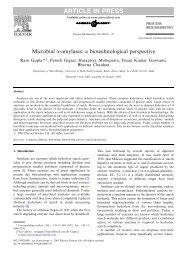Protein engineering from a bioindustrial point of view
Protein engineering from a bioindustrial point of view
Protein engineering from a bioindustrial point of view
You also want an ePaper? Increase the reach of your titles
YUMPU automatically turns print PDFs into web optimized ePapers that Google loves.
418 <strong>Protein</strong> <strong>engineering</strong><br />
a/. [9] have successfully applied directed evolution to<br />
improve the whole cell fluorescence by green fluorescent<br />
protein, which is widely used as a reporter for gene<br />
expression and regulation.<br />
An evolutionary approach has been used by You and<br />
Arnold [lo] to give a 471-fold increase in the activity<br />
<strong>of</strong> subtilisin E in 60% aqueous dimethyl formamide.<br />
Their paper was important in demonstrating the possibility<br />
<strong>of</strong> <strong>engineering</strong> enzymes to perform in organic solvents,<br />
very different conditions <strong>from</strong> their natural environments.<br />
Building upon this work, this group applied the directed<br />
evolution approach to develop an esterase capable <strong>of</strong><br />
carrying out a particular deprotection step <strong>of</strong> an antibiotic<br />
synthesis in aqueous-organic solvents [ll”]. At the time<br />
<strong>of</strong> writing, two quite different ways <strong>of</strong> implementing<br />
directed evolution have been published. The Arnold<br />
group [lO,l l**] screens through single and then higher<br />
multiples <strong>of</strong> variants to cover sequence space systemati-<br />
cally. Stemmer’s group [6-91 relies on examining large<br />
numbers <strong>of</strong> variants with multiple mutations using high<br />
definition screens or selection to find the best one. The<br />
preferred approach may depend on the nature <strong>of</strong> the<br />
problem and the type <strong>of</strong> selection or screens that can be<br />
developed. In fact, the development <strong>of</strong> high-throughput<br />
screening methods along with screens that accurately<br />
reflect the property that is being engineered for final use,<br />
is a critical area for success when using directed evolution.<br />
Not many publications <strong>of</strong> screening methods are available,<br />
but a paper describing a simple and effective screening<br />
method for proteases has recently been published [12’].<br />
Sources <strong>of</strong> material to be engineered<br />
In addition to the substantial effort made by enzyme<br />
suppliers and industrial users to improve existing enzymes,<br />
extremeophiles are being aggressively pursued to provide<br />
new enzymes [13] that are highly thermostable, salt<br />
tolerant, cold active, and so on, depending on the<br />
environment <strong>of</strong> the native organism. Very interesting<br />
enzymes may be isolated <strong>from</strong> bacteria on a worm that<br />
resides near thermal vents in the ocean, and are expected<br />
to have a much broader temperature pr<strong>of</strong>ile <strong>of</strong> activity<br />
than normal mesophilic or thermophilic enzymes [14].<br />
Such enzymes could function effectively across the variety<br />
<strong>of</strong> temperature conditions encountered in global laundry<br />
applications.<br />
The de nom design <strong>of</strong> proteins, although very challenging,<br />
<strong>of</strong>fers the broadest possibilities for new structures. In one<br />
<strong>of</strong> the first practical applications, a de nova four helix<br />
bundle protein [15] was designed to serve as a source<br />
<strong>of</strong> scarce amino acids (methionine, threonine, lysine and<br />
leucine) when expressed in the rumen bacteria <strong>of</strong> dairy<br />
cows [16]. A related concept is to create small protein-like<br />
molecules, either by copying natural motifs [17] or via<br />
templates [l&19], which can serve as ‘molecular scaffolds’<br />
for groups introducing functional properties. For example,<br />
a natural scaffold consisting <strong>of</strong> the 37 amino acid toxin<br />
<strong>from</strong> scorpions has been used to design a metal-bindi<br />
site that mimics the one found in carbonic anhydrase [Zr<br />
The successful introduction <strong>of</strong> the metal-binding si<br />
supports the idea that protein <strong>engineering</strong> in this mann<br />
may yield functional materials in the future.<br />
Tailoring fundamental properties<br />
Stability<br />
Since the conditions in which industrially importa<br />
proteins are used <strong>of</strong>ten differ <strong>from</strong> their natural e<br />
vironment, stability is a necessary consideration 1<br />
most engineered proteins. The introduction <strong>of</strong> disulfi<br />
bonds [Zl], chemical cross-links [Z?‘], and salt bridg<br />
[23] has been widely used to increase stability, althou,<br />
not all disulfide bonds increase stability. Recent wo<br />
on barnase by X-ray crystallography [24] and hydrog<br />
exchange [‘25] shows that those disulfide bonds that do n<br />
improve stability disrupt the local structure. The definiti<br />
<strong>of</strong> an effective salt bridge interaction has perhaps be<br />
sharpened by the recent observation by Tanner et al. [Z!<br />
By comparing a number <strong>of</strong> glyceraldehyde phosphz<br />
dehydrogenase structures <strong>from</strong> organisms with differe<br />
heat tolerance they found a strong correlation betwe<br />
increased thermostability and the number <strong>of</strong> hydrog<br />
bonds involving charged sidechains and neutral partne<br />
On the other hand, for the Arc protein [27], a buried s<br />
bridge between arginine and glutamic acid was found<br />
provide less stability than hydrophobic residues. Althou<br />
not necessarily contradictory to Tanner’s observation<br />
since this is presumably a charge+harge salt bridge, it dc<br />
suggest that the contribution <strong>of</strong> salt bridges to stabil<br />
remains unresolved.<br />
Activity<br />
Although improving the activity <strong>of</strong> an industrial enzyr<br />
is <strong>of</strong>ten a primary goal, it is also one <strong>of</strong> the mc<br />
complex. This is partly because in many applicatia<br />
<strong>of</strong> enzymes the substrate is chemically complex a<br />
heterogeneous. It is reassuring in such a context to fi<br />
the principle <strong>of</strong> transition state stabilization verified<br />
a relatively simple system. In a study <strong>of</strong> the hydroly<br />
<strong>of</strong> acetylcholine by acetycholinesterase [ZS], the cataly<br />
acceleration corresponding to 18 kcal mol-1 <strong>of</strong> transiti<br />
state stabilization could be accounted for in terms<br />
specific molecular interactions, as identified in the crys<br />
structure <strong>of</strong> a transition state analog inhibitor with TOQC<br />
californica acetylcholinesterase. A quantitative method<br />
analyze the similarity <strong>of</strong> substrates and inhibitors, w<br />
respect to their enzyme stabilized transition states,<br />
the purpose <strong>of</strong> designing more effective transition st;<br />
inhibitors has also recently been published [29].<br />
For more complex reactions, such as the hydrolysis<br />
protein amide bonds by a protease, much less is knov<br />
In a revealing study on the proteolysis <strong>of</strong> variants o<br />
single chain Monellin (a sweet protein consisting <strong>of</strong><br />
amino acids), the extent <strong>of</strong> proteolysis at a fixed til<br />
correlated with the free energy <strong>of</strong> protein unfoldi










